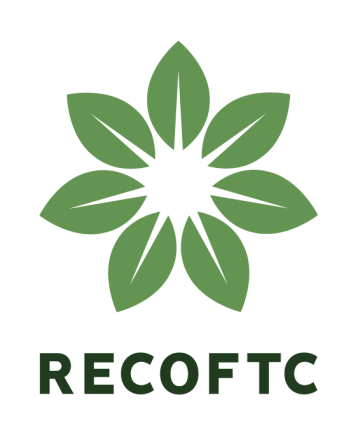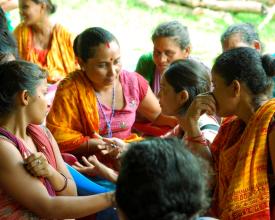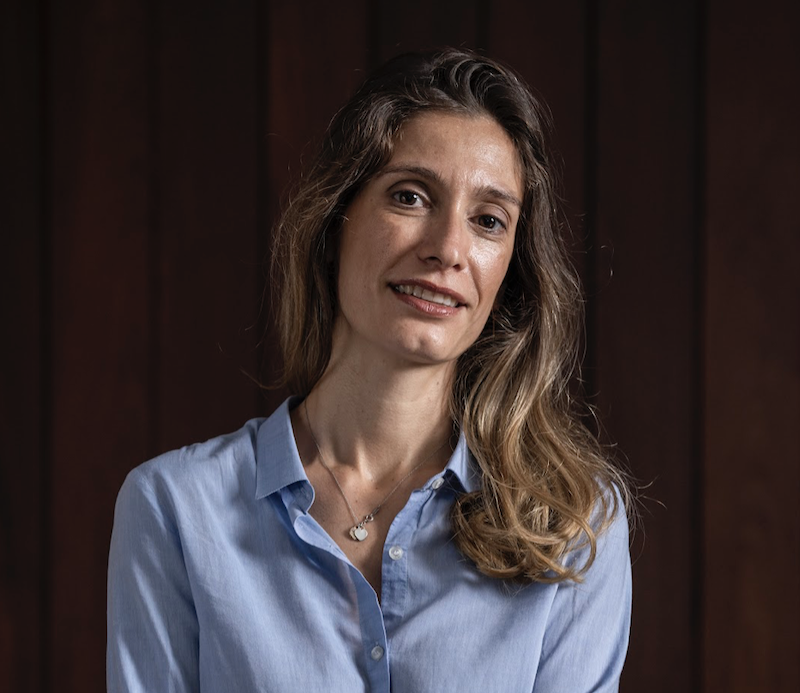
Mejorar los medios de subsistencia, abordar la desigualdad de género y adaptarse al cambio climático en un bosque comunitario dirigido por mujeres en Bishnupur (Nepal).

En 2014, RECOFTC puso en marcha un proyecto en Bishnupur para mostrar cómo la silvicultura comunitaria empodera a las mujeres y favorece la adaptación al cambio climático. La silvicultura comunitaria es un término amplio que engloba enfoques que capacitan a la población local para gestionar, proteger y beneficiarse de los bosques. El proyecto se desarrolló con el grupo de usuarias forestales comunitarias de Bishnupur, dirigido por mujeres. RECOFTC, el gobierno local y agencias sectoriales ayudaron al grupo a aplicar un enfoque participativo para evaluar la vulnerabilidad climática e identificar y ejecutar acciones prioritarias. Protegieron las tierras de labranza de las inundaciones plantando árboles, instalaron terraplenes biológicos para estabilizar las riberas de los ríos que se derrumbaban, invirtieron en pozos para mejorar el suministro de agua e introdujeron la agrosilvicultura y la apicultura para diversificar los medios de subsistencia. La comunidad mejoró su resiliencia y redujo su vulnerabilidad a las perturbaciones climáticas y de otro tipo. El proyecto empoderó a las mujeres como líderes, responsables de la toma de decisiones y beneficiarias financieras. El impacto transformador llevó a las mujeres de las comunidades vecinas a adoptar prácticas similares.
Contexto
Défis à relever
Medio ambiente
La producción de caña de azúcar reduce la calidad del suelo y la disponibilidad de agua. La deforestación y el cambio de uso del suelo agravan los efectos del cambio climático. Estos impactos incluyen inundaciones repentinas anuales que erosionan las riberas de los ríos y han provocado la pérdida de unas 30 hectáreas de tierra. La irregularidad de las estaciones y la variabilidad de las precipitaciones agravan la insuficiencia de recursos hídricos. Las especies invasoras amenazan a las especies autóctonas del bosque.
Social
Las desigualdades de género son notables en Bishnupur, con una carga de trabajo doméstico desigual entre hombres y mujeres. Esta brecha se ha acentuado a medida que han disminuido las fuentes de agua y las mujeres han tenido que dedicar hasta dos horas diarias más a recoger agua. Las mujeres también tienen una voz limitada en los espacios de toma de decisiones. El acceso desigual a los recursos hídricos entre los hogares relativamente acomodados y los más pobres ha creado tensiones sociales.
Económico
La pobreza está muy extendida. Los ingresos del principal cultivo comercial, la caña de azúcar, están disminuyendo. La dependencia de la agricultura aumenta la vulnerabilidad, ya que la productividad agrícola está disminuyendo.
Ubicación
Procesar
Resumen del proceso
Los componentes básicos son las tres fases principales de la adaptación al cambio climático basada en la silvicultura comunitaria. Siguen una secuencia. En primer lugar está la evaluación de la vulnerabilidad y la identificación de los temas de adaptación. A continuación, se evalúa la viabilidad de las opciones de adaptación específicas. En esta segunda fase, se identifican las posibles opciones de adaptación integradas y se exploran las prioridades y oportunidades de financiación. Como parte de esta fase, se elaboran propuestas de proyectos y se colabora con las instituciones asociadas. En la tercera y última fase se llevan a cabo las intervenciones. Las actividades dan prioridad a los hogares pobres, los grupos étnicos y castas desfavorecidos y las mujeres. A lo largo de las tres fases del proceso se realiza un seguimiento participativo. El proceso se completa con una evaluación.
Bloques de construcción
Evaluación participativa de la vulnerabilidad climática
El objetivo es comprender las vulnerabilidades a los impactos del cambio climático. Tras un proceso de consentimiento libre, previo e informado con las partes interesadas, la evaluación de la vulnerabilidad a nivel comunitario identifica las amenazas e impactos climáticos, evalúa las amenazas e impactos sobre los activos de los medios de vida comunitarios e identifica las vulnerabilidades y los temas de respuesta a la vulnerabilidad.
En Bishnupur, un coordinador local apoyó la evaluación durante seis meses. Una trabajadora sobre el terreno de la Himalayan Grassroots Women's Natural Resource Management Association consultó a las mujeres interesadas, ya que se consideró inapropiado que los trabajadores varones se relacionaran con las mujeres.
Una serie de matrices permiten recopilar, organizar y evaluar claramente la información socioeconómica y sobre el cambio climático para evaluar las vulnerabilidades. Cada matriz se basa en la información recogida en la anterior. Las variables climáticas y los sectores expuestos analizados en las matrices dependen de factores específicos del lugar.
Las matrices se completan utilizando datos primarios y secundarios. Los datos primarios proceden de la evaluación rural participativa y de la investigación-acción participativa. Los datos secundarios proceden de las directrices y los planes operativos de los grupos de usuarios forestales comunitarios, las oficinas gubernamentales de los distritos y los institutos de investigación forestal y de ordenación del territorio.
Factores facilitadores
Los grupos de usuarios forestales comunitarios de Nepal utilizan procesos participativos y poseen la información socioeconómica y biofísica necesaria para evaluar la vulnerabilidad. Las partes interesadas deben estar dispuestas a trabajar juntas: el gobierno local y organismos sectoriales como la Oficina Forestal del Distrito apoyaron el proceso en Bishnupur. Es fundamental contar con un facilitador experimentado y sensible al contexto local. Debe estar familiarizado con los complejos aspectos de la vulnerabilidad climática objeto de evaluación y ser capaz de crear espacios y oportunidades para reconocer la relevancia de las voces de la comunidad.
Lección aprendida
La falta de datos empíricos es un reto para la realización de evaluaciones de vulnerabilidad a nivel comunitario y local. Las herramientas participativas para cartografiar las tendencias climáticas pueden ayudar a superar el reto hasta cierto punto. Las pruebas empíricas siguen siendo importantes para analizar y validar la información que comparten los miembros de la comunidad.
Por ejemplo, la comunidad de Bishnupur interpretó que las tendencias climáticas conducían a la sequía. Los días de lluvia habían disminuido, pero los datos meteorológicos mostraban que las precipitaciones globales habían aumentado. Tras informar a la comunidad del hallazgo, el proyecto dio prioridad a la gestión y captación de agua como área clave de intervención.
Los procesos de evaluación de la vulnerabilidad climática pueden ser una oportunidad para concienciar sobre el cambio climático a los miembros de la comunidad y otras partes interesadas. En el proceso de evaluación de la vulnerabilidad en Bishnupur se invitó a representantes del gobierno local y de organismos sectoriales. Contribuyeron al análisis y se beneficiaron de una comprensión matizada de cómo el cambio climático está afectando a las comunidades y qué medidas tomar. Esto ayudó a garantizar su apoyo para poner en marcha intervenciones de adaptación.
Coproducción de la evaluación de la viabilidad de la intervención de adaptación
Una evaluación de viabilidad utiliza las aportaciones de los miembros de los grupos de usuarios forestales comunitarios y otras partes interesadas para identificar las intervenciones de adaptación.
En primer lugar, los miembros del grupo de usuarios forestales de la comunidad y los facilitadores revisan la evaluación de la vulnerabilidad climática y los temas de intervención identificados. La evaluación identifica al menos tres temas basados en las amenazas climáticas detectadas, las vulnerabilidades y las capacidades de adaptación. Cada tema es una amplia estrategia de adaptación con acciones.
A continuación, los facilitadores utilizan una plantilla para evaluar los temas con el fin de ayudar a los miembros del grupo de usuarios forestales de la comunidad a buscar conocimientos técnicos, y cotejan la información en un único documento "instantáneo" para permitir la selección de una acción más detallada. Los facilitadores pueden utilizar la evaluación de la vulnerabilidad climática para redactar de antemano la información sobre los medios de subsistencia existentes.
Como paso final, los facilitadores trabajan con los miembros del grupo de usuarios forestales de la comunidad para elaborar una lista de expertos y expertos para los temas de intervención. Los facilitadores actualizan la lista, según sea necesario, teniendo en cuenta una amplia gama de partes interesadas y proveedores de servicios. Las matrices finales enumeran las opciones de respuesta para cada tema y se completan basándose en la información proporcionada por los participantes objetivo. Esta sección puede requerir la recopilación de información de consultores técnicos y/o proveedores de servicios.
Factores facilitadores
Mientras que las evaluaciones de vulnerabilidad deben ser participativas, las de viabilidad requieren conocimientos técnicos para determinar qué opciones son prácticas y eficaces. Es probable que para ello haya que recurrir a organismos o consultores de ingeniería, hidrología, agricultura u otros. La participación de organizaciones gubernamentales y no gubernamentales en una evaluación de la vulnerabilidad reducirá los esfuerzos necesarios para la evaluación de la viabilidad, al proporcionar información sobre las posibles medidas ya disponibles o aplicadas, las tecnologías necesarias, los costes y las posibles fuentes de apoyo.
Lección aprendida
Los grupos comunitarios de usuarios de los bosques pueden llevar a cabo evaluaciones de viabilidad, con el apoyo técnico de los organismos de apoyo. El liderazgo de las mujeres garantiza que las intervenciones tengan suficientemente en cuenta las repercusiones y los beneficios para ellas y otros grupos marginados, como los hogares pobres y las minorías étnicas.
En Nepal, el apoyo a la adaptación al cambio climático está encomendado a muchos organismos locales. Por esta razón, identificar y comprometer a las agencias técnicas es una valiosa oportunidad para desarrollar planes de cofinanciación. Las peticiones de aportaciones técnicas refuerzan los argumentos a favor del apoyo financiero a las intervenciones.
Aplicación de intervenciones de adaptación basadas en los ecosistemas
El objetivo es utilizar las intervenciones basadas en la naturaleza identificadas por la evaluación de viabilidad para abordar las fuentes de vulnerabilidad climática. Para ello, los líderes del grupo de usuarios forestales de la comunidad movilizan recursos y personas, y trabajan con organizaciones asociadas identificadas en la evaluación de viabilidad para acceder a recursos y tecnología.
En Bishnupur, las mujeres líderes del grupo de usuarios del bosque comunitario trabajaron con RECOFTC para comprar unos 300 plantones de mango y lichi a precios subvencionados en el centro regional de desarrollo hortícola. RECOFTC proporcionó colmenas y formación en apicultura.
Para hacer frente a la escasez de agua y proteger las fuentes existentes, el grupo de usuarios forestales de la comunidad accedió a la ayuda técnica y financiera del Proyecto de Riego Bagmati del gobierno para instalar un pozo profundo. RECOFTC y el grupo de usuarios del bosque cubrieron el déficit de financiación.
Para estabilizar la ribera, los miembros del grupo construyeron un muro de contención de piedras y sacos de arena cubierto con bambú vivo y otras plantas a lo largo de un kilómetro de río. Plantaron 200 rizomas de bambú y 4.000 plantones de cultivos forrajeros de la Oficina Forestal del Distrito y la Oficina de Conservación del Suelo del Distrito, junto con hierba multiusos de crecimiento rápido disponible localmente.
Factores facilitadores
El proceso fue dirigido localmente. La apropiación local contribuyó a que los líderes forestales de la comunidad de Bishnupur exploraran por su cuenta posibles ayudas. La facilitación de terceros es importante, ya que las propuestas de una comunidad pueden no ser las más sensibles al clima, o las óptimas para las comunidades cercanas y su propia resiliencia climática. El apoyo político es crucial. Por ejemplo, el Programa Nacional de Acción para la Adaptación de Nepal establece que el 80% de los recursos para la adaptación al clima deben destinarse al ámbito local, lo que facilita el acceso a la financiación.
Lección aprendida
Un grupo de usuarios forestales comunitarios constituye una institución sólida y autónoma que, en cierta medida, dispone de los recursos necesarios para llevar a cabo las intervenciones. Estos grupos cuentan con redes sólidas que pueden ayudarles a acceder a más recursos y apoyo técnico cuando sea necesario.
La adaptación climática liderada por mujeres ayuda a abordar tanto la desigualdad de género como la vulnerabilidad climática, especialmente la de las mujeres y los miembros más pobres de una comunidad.
Impactos
El proyecto aumentó la cubierta arbórea y diversificó los ingresos proporcionando 300 árboles de mango y lichi, 1.000 árboles de mantequilla (de nombre local chiuri) y 500 árboles de laurel indio (de nombre local tejpat). Los ingresos anuales aumentaron una media de 45.000 rupias (450 dólares), o alrededor del 18%, para seis familias que recibieron colmenas y apoyo técnico para producir miel.
La perforación de un pozo profundo mejoró el acceso al agua de 64 familias para uso doméstico y agrícola en 30 hectáreas, reduciendo la vulnerabilidad a las precipitaciones variables. Las relaciones con las autoridades locales mejoraron gracias a que un proyecto de irrigación dirigido por el gobierno cofinanció el pozo.
El proyecto estabilizó un tramo de 1 km de longitud de la ribera del río, utilizando sacos de arena y piedras reforzadas con plantaciones de bambú, para reducir la erosión durante las lluvias torrenciales o las crecidas repentinas. Desde 2015, no ha habido erosión de la ribera a pesar de las crecidas repentinas anuales. Se han depositado menos sedimentos y escombros en las 45 hectáreas de bosques, granjas y asentamientos de la aldea.
El proyecto mejoró la cohesión de la comunidad, mitigando las tensiones sociales por el acceso al agua. Redujo la desigualdad de género y empoderó a las mujeres como líderes de la adaptación al clima. La preparación y aplicación de un componente de respuesta al cambio climático en el plan comunitario de gestión forestal ayudó a integrar la adaptación y a garantizar que el bosque almacene unas 888 toneladas de carbono. Otras 39 comunidades de tres distritos están reproduciendo estos esfuerzos.
Beneficiarios
- Once mujeres que dirigen el grupo de usuarios del bosque comunitario de Bishnupur y 63 familias (359 personas) que son miembros del grupo
- 778 personas activas en empresas comunitarias apoyadas por otros proyectos.
Objetivos de Desarrollo Sostenible
Historia

Mausami Uprety y su marido Wakil Mainali viven en Bishnupur con sus dos hijas pequeñas. Antes de que el Centro Regional de Capacitación en Silvicultura Comunitaria para Asia y el Pacífico (RECOFTC) pusiera en marcha su proyecto allí, la familia vivía en la extrema pobreza.
"Nos ganábamos la vida cultivando verduras y trabajando en las granjas de otros", explica Uprety. "Antes era muy difícil. No había trabajo ni fuente de ingresos que pudiéramos utilizar en tiempos de necesidad".
El cambio climático agravó la precaria existencia de la familia. Uprety cuenta que su comunidad se había visto afectada por unas inundaciones y una degradación del suelo cada vez peores. Pero cuando se unió al grupo de usuarios del bosque comunitario de Bishnupur, otras mujeres miembros le hablaron de las oportunidades que podía brindar la apicultura. Con el apoyo técnico y de gestión de RECOFTC, Uprety y otras cinco nuevas apicultoras pudieron garantizar la sostenibilidad de sus negocios.
"Descubrí que la apicultura es una empresa de bajos insumos y altos ingresos", afirma. "Proporciona ingresos regulares. Es buena para las familias pobres".
"Antes sólo tenía una cabra", añade. "Cuando empecé a ganar dinero con la apicultura, pude aumentar el rebaño de cabras. La miel también ha sido una fuente de nutrición para mis hijos".
La apicultura y otras prácticas agroforestales hacen que agricultores como Uprety ya no tengan que depender de una sola fuente de ingresos.
"En lugar de plantar caña de azúcar, empecé a plantar mango en mis tierras", dice Bishnu Mahat, miembro del comité ejecutivo del grupo de mujeres usuarias de silvicultura comunitaria de Bishnupur. "La caña de azúcar consume demasiada agua y está secando la tierra, al tiempo que reduce la productividad. Espero que el mango me proporcione mejores beneficios que la caña de azúcar y diversifique mi fuente de ingresos."
El éxito del proyecto Árboles y Abejas de RECOFTC en Bishnupur se ha extendido. Los programas dirigidos por el gobierno están reproduciendo el proyecto en los distritos vecinos de Siraha y Saptari. Los programas apoyan ahora a otras personas que luchan por mantener sus medios de subsistencia ofreciéndoles formación y asistencia técnica para iniciarse en la apicultura.












